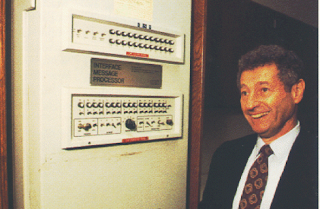Posted by Abirama on Tuesday, February 14, 2017 in Internet | No comments
We now live in a golden age of technology, there are so many technology or inventions that help us in so many way like smartphone, computer, television, etc. But there's one technology or invention that keep the world go round. Without this technology, our life will stop. What is that? Yes, it's the Internet. Today we use internet for almost everything. From searching for a job, find your way home, find your homework's answer, or maybe you just want to play games with people around the world!
You can do everything with the internet, but unfortunately not everyone can accessed the Internet. Probably because the area is too far away to reach the Internet network, the lack of attention from the local government, and many more. But did you know? The history of the internet began with the invention of a computer network technology in 1960. Well, no time to spare, let's look at history more detail through the following explanation.
The History Of The Internet
It's all began in august 1962, and the creation of the Internet was first suggested by someone named J.C.R Licklider of MIT Massachutts Institute of Technology. The initial concept called "Galactic Network" by himself. He argues about how the global network that enables people to access data and programs from anywhere. In October 1962 he headed the computer research program at ARPA which is part of the United States Defense Department.
The project of ARPANET was to design a form of network, reliability, and how much information can be transferred, which ultimately all the standards that they set, become a pioneer of development of a new protocols that we know by TCP / IP (Transmission Control Protocol / Internet Protocol).
The initial purpose of the construction project was for military purposes. At that time the US Department of Defense (US Department of Defense) to make a computer network system that is spread by linking computers in areas vital to address the problem of a nuclear attack and to avoid the occurrence of centralized information, which in the event of war can be easily destroyed.
In 1966 Larry Roberts developed the concept of computer networks. Then he plans a network called ARPANET which was published in 1967. In 1969 ARPANET had involved four computers connected.
The history of the internet begins with the first computers located at the University of California Los Angeles, the second computer at Stanford Research Institute, a third computer is located at the University of California Barbara and fourth computer located at the University of Utah. In 1971, the number of computers connected to the ARPANET reached 14 units. This year also the Telnet and FTP protocols successfully constructed. In 1972, Larry Roberts and Bob Kahn introduced ARPANET at ICCC conference held in Washington.
In 1972, the history of the Internet developments explains Ray Tomlinson write programs that enable electronic mail is sent to the network ARPNET. It was he who designed the conversion of "user @ host." In the same year the ARPANET uses NCP to transfer data. In the same year ARPA are changed its name to DARPA. The additional letter D comes from the Defense. At this year's international ARPANET connects first with the University College of London and the Royal Establishment in Norway.
In 1978, Unix to Copy Protocol found in Bell labs. This program is useful for file transfer. In 1979 a news group named USENET operates on the basis of UUCP. Its creator is Tom Truscott and Jim Ellis (both students at Duke University) and Steven Bellovin (from the University of North Carolina).
Users from around the world join this discussion group to discuss network issues, politics, religion and various other topics. In 1982 the DCA or the Defense Communications Agency and DARPA formed a protocol called TCP / IP on the ARPANET. Furthermore, the US Department of Defense declared TCP / IP as a standard. That's when the internet is defined as a collection of connected networks using TCP / IP as a protocol.
In 1983, was John Postel and Paul Mockapetris and Craig Partidge develop the Domain Name System (DNS) and proposed user@host.cdomain shaped observation systems. DNS was introduced in 1984 on the internet by mentioning the names of such types of domains .gov, .mil, .org, .net and .com.
In 1986, TCP / IP became available in workstation and PC. This year, the National Science Foundation funded NSFNET backbone Internet capacity of 56 kbps and regulate the Internet is only intended for research purposes and the government that are not commercially viable.
In 2000, The Internet is growing so rapidly, this can be evidenced by the emergence of billions of websites in the world. And digital business has become a trend of the development of the internet.
Internet history has proved that technology is developing very rapidly from 90's to the present. There are so many people who use the internet, and comes billions of sites that can be found easily. The Internet can be a place of education for all, as well as entertainment effective and easy to implement.












0 comments:
Post a Comment